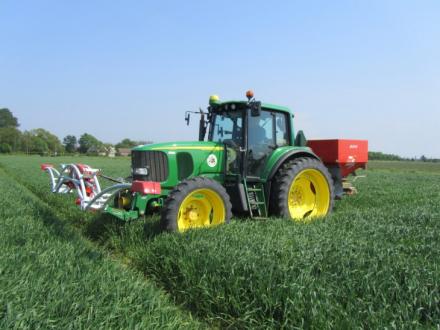Agriculture faces significant challenges, there is ever-increasing pressure on profit margins and farmers are also trying to produce food in the most sustainable way possible.
The AGRO SHOW in Bednary, near Poznan, is an opportunity for  companies to showcase the latest technologies to help farmers work as efficiently as possible. Precision farming makes use of satellite technology allowing real-time management of crops, fields and animals. It helps to monitor and reduce the environmental impact of farming. This is underlined, for instance, by the “European Innovation Partnership for Agricultural Productivity and Sustainability (EIP-AGRI). This Partnership was launched in 2012 by the European Commission (DG AGRI) to contribute to the European Union's 'Europe 2020' strategy for smart, sustainable and inclusive growth, in which precision farming plays a key role.
companies to showcase the latest technologies to help farmers work as efficiently as possible. Precision farming makes use of satellite technology allowing real-time management of crops, fields and animals. It helps to monitor and reduce the environmental impact of farming. This is underlined, for instance, by the “European Innovation Partnership for Agricultural Productivity and Sustainability (EIP-AGRI). This Partnership was launched in 2012 by the European Commission (DG AGRI) to contribute to the European Union's 'Europe 2020' strategy for smart, sustainable and inclusive growth, in which precision farming plays a key role.
The Bednary show focuses on arable farming. Combining sensor technologies with software linked to EGNOS and Galileo allows farmers to monitor and react to what is happening on the ground. Sensors can pick up on water, nutrient and pesticide levels. The technology will identify where product is needed and the best way to deliver this on the ground. It is also used for seeding and harvesting.
Most producers of agricultural vehicles have incorporated satellite receivers into their machinery to make sure they can offer the highest levels of productivity to farmers. We spoke to three companies to find out how they were making use of GNSS to help farmers.
‘Precision engineering is becoming more and more important in modern agriculture’
Karl Wilhelm Hundertmark, CLAAS Polska, spoke about the role of precision machinery in agriculture, which he said is becoming more and more important. He said that machines were now installed with standard informatics tools that, for example, help to manage fuel consumption and carry out early diagnosis of machine faults. CLAAS, like many manufacturers, install EGNOS as standard in all their agricultural vehicles and for ploughing and spraying it is particularly useful. For seeding, further accuracy is needed, down to as little as two to three centimetres.
Galileo enabled device for precision agriculture
Jerzy Koronczok, Agrocom Polska presented the software developed in the course of the Geopal H2020 project, which can be accessed through any computer. This tool also requires a small Galileo enabled device. This little box (see photo) is useful to all farmers, including small farmers, as it can be added to older machinery. It works with a tablet or smart phone and is a cost-effective solution to digitally document all the farm’s machinery and equipment. Movement and location are easily monitored through the application, which makes use of Galileo satellite signals. Free of charge in its basic version, farmers can tailor it to their specific needs. Farmers can also decide which additional components they need to buy, so that they only pay for what they really need.
‘Customers can save a lot of money on all agriculture products through technology’
Bogdan Kazimierczak, Product Sales Specialist with John Deere Polska, stood beside a large picture of a tractor on the moon! The image makes the point that precision farming tools use satellite information. Kazinierczak explained that these technologies save farmers a lot of money on fertilizers, pesticides and fuel. He said that even smaller farms of 75 hectares can make use of applications to help manage their properties as efficiently as possible.
Kazinierczak says that there are also benefits for the environment. Precision agriculture can reduce the risk of excess chemicals going into the ground by making use of section controls. For example, in an area where chemicals can’t be used, the system will be shut off and no chemicals will be sprayed. So, developments in the agriculture sector are showing that, as highlighted in a European Parliament study on precision agriculture, “suitable services from GNSS developments (Galileo) as a key feature of Precision Agriculture are a priority, but also more easily available data from remote sensing programmes (Copernicus) can be a stimulant to improving Precision Agriculture applications.”
So, it seems that exploiting the synergies between Galileo and Copernicus is the way forward for agriculture.
Media note: This feature can be republished without charge provided the European GNSS Agency (GSA) is acknowledged as the source at the top or the bottom of the story. You must request permission before you use any of the photographs on the site. If you republish, we would be grateful if you could link back to the GSA website (http://www.gsa.europa.eu).